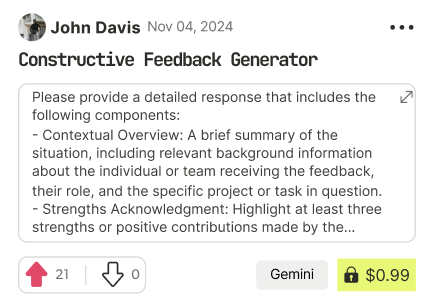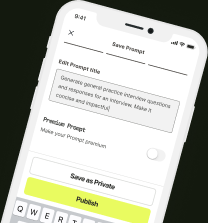prompt mine App
Find, Create & Share AI Magic
**Decision-Making Mastery: A Framework for Leaders**
Okay, let's get you operating at the level of a Fortune 500 CEO when it comes to making decisions. We'll tackle this in stages, just like a strategic planning session. First, we need to understand your current process, then we'll build a streamlined framework, and finally, we'll address fatigue, speed, and regret.
Phase 1: Analyzing Your Current Decision-Making Process
To understand your current process, I need you to think about the last three significant decisions you made (one personal, one work-related, and one relatively minor). For each decision, mentally walk through these questions (you don't need to write down the answers now, but be honest with yourself):
1. Trigger: What prompted the need for a decision?
2. Information Gathering: How did you gather information? Did you research extensively, rely on gut feeling, consult others, or use a combination?
3. Option Generation: How many options did you actively consider? Did you brainstorm multiple possibilities, or did you quickly narrow it down to one or two?
4. Evaluation Criteria: What criteria did you use to weigh the options? Were these criteria explicit (written down) or implicit (just in your head)?
5. Decision Point: How did you finally make the choice? Was it a logical process, an emotional one, or a combination?
6. Post-Decision Reflection: After making the decision, did you second-guess yourself? Did you feel satisfied or anxious?
7. Time Consumption: How long is spent in different phases of the decision making process?
Most likely, you'll find some inconsistencies and inefficiencies. Common issues include:
Overthinking: Spending too much time gathering information and analyzing options, leading to "analysis paralysis."
Lack of Clear Criteria: Making decisions based on vague feelings rather than specific, measurable objectives.
Ignoring Gut Instinct: Over-relying on data and neglecting the valuable insights your intuition provides.
Emotional Bias: Letting emotions cloud judgment, leading to suboptimal choices.
Inconsistancy: Using different, non-replicable processes for each deicison.
Phase 2: A Streamlined Decision-Making Framework (The "CEO Decision Matrix")
This framework is designed for speed, clarity, and effectiveness. It's adaptable to both major strategic decisions and smaller, everyday choices.
1. Define the Objective (The "Why"): Before anything else, clearly articulate what you're trying to achieve with this decision. What is the desired outcome? Be specific. Instead of "improve marketing," aim for "increase lead generation by 20% in Q3."
Example: "Increase website traffic by 15% in the next month."
2. Set Constraints (The "Boundaries"): Identify any limitations or non-negotiables. This includes budget, time, resources, ethical considerations, and legal requirements.
Example: "Budget of $5,000; must be implemented within two weeks; must comply with all existing company policies."
3. Identify Key Criteria (The "Priorities"): List 3-5 essential criteria that will determine the best option. Weight them if necessary (e.g., cost = 30%, speed = 40%, risk = 30%).
Example:
Cost (30%)
Time to Implement (40%)
Potential ROI (30%)
4. Generate 2-3 Viable Options (The "Contenders"): Don't aim for perfection; aim for viable. Two or three good options are enough. More than that often leads to paralysis.
Example:
Option A: Run targeted social media ads.
Option B: Launch a content marketing campaign.
Option C: Partner with an influencer.
5. Rapid Evaluation (The "Scorecard"): Quickly assess each option against your key criteria. Use a simple scoring system (e.g., 1-5, with 5 being the best).
Example: (Using the criteria and options above)
| Option | Cost (30%) | Time to Implement (40%) | Potential ROI (30%) | Total Score |
| ------ | ---------- | ----------------------- | ------------------ | ----------- |
| A | 4 | 5 | 3 | 4.1 |
| B | 3 | 2 | 4 | 2.9 |
| C | 2 | 4 | 5 | 3.6 |
6. Gut Check & Intuition (The "Reality Check"): After the scoring, take a step back. Does the "winning" option feel right? Your intuition is a powerful tool honed by experience. If something feels significantly off, re-examine your criteria or options. Don't ignore your gut, but don't solely rely on it either.
7. Decide & Commit (The "Action"): Make the decision based on the combined results of the evaluation and your gut check. Once you've made the choice, commit fully. Avoid second-guessing (we'll address that later).
8. Document Rationale (The "Record"): Briefly jot down why you made the decision. This is crucial for future learning and accountability.
Example: "Chose Option A because it offered the best balance of speed and cost-effectiveness, despite a slightly lower projected ROI than Option C. Gut check felt positive, aligning with our overall strategic goals."
9. Review and Adapt (The "Feedback Loop") Sometime after the decision is made, review it. Was it the right one?
Phase 3: Eliminating Decision Fatigue, Speeding Up, and Avoiding Regret
Now, let's address the specific challenges you mentioned:
Eliminating Decision Fatigue:
Standardize Routine Decisions: Create templates or default choices for recurring decisions. What to wear, what to eat for lunch – these shouldn't require significant mental energy. Automate where possible.
Time Blocking: Allocate specific times for decision-making. Don't let decisions bleed into every part of your day.
Prioritize Ruthlessly: Focus on the vital few decisions that truly matter. Delegate or eliminate the rest. Learn to say "no" to non-essential requests.
Optimize Your Environment: Ensure you're making important decisions when you're well-rested, well-fed, and in a conducive environment (minimal distractions).
Batch Decisions: Group similar decisions together. For example, respond to all emails at once, rather than sporadically throughout the day.
Making Faster, Better Decisions with Less Information:
Embrace the 80/20 Rule: Often, 80% of the value comes from 20% of the information. Focus on gathering the critical information, not all the information.
Set Time Limits: Give yourself a deadline for making a decision. This forces you to prioritize and prevents overthinking.
"Satisfice," Not "Maximize": Aim for a "good enough" solution, not a perfect one. Perfection is the enemy of progress.
Trust Your Intuition (Again): Your subconscious mind processes vast amounts of information. Learn to tap into that wisdom.
Use the "Two-Minute Rule": If a decision can be made in two minutes or less, make it immediately. Don't defer it.
Avoiding Regret and Second-Guessing:
Focus on the Process, Not Just the Outcome: If you followed a sound decision-making process (like the CEO Decision Matrix), you've done your best. Outcomes are often influenced by factors outside your control.
Accept Imperfection: No decision is perfect. There will always be trade-offs and potential downsides.
Reframe "Failure": View "wrong" decisions as learning opportunities. What did you learn? How can you improve your process next time?
Practice Self-Compassion: Don't beat yourself up over past decisions. Acknowledge your efforts, learn from your mistakes, and move on.
The "Pre-Mortem": Before making a major decision, imagine it has failed spectacularly. What went wrong? This can help you identify potential pitfalls and adjust your approach.
Documenting the Rationale Refer back to your decision making process and the logic that lead to the decision.
This framework is a starting point. Adapt it to your specific needs and context. The key is to be intentional about your decision-making process, rather than letting it be a haphazard series of reactions. By implementing these strategies, you'll make better decisions, faster, with less stress and regret, just like the top CEOs I've coached. Remember, consistent practice is key to mastery.

Find Powerful AI Prompts
Discover, create, and customize prompts with different models, from ChatGPT to Gemini in seconds

Simple Yet Powerful
Start with an idea and use expert prompts to bring your vision to life!

